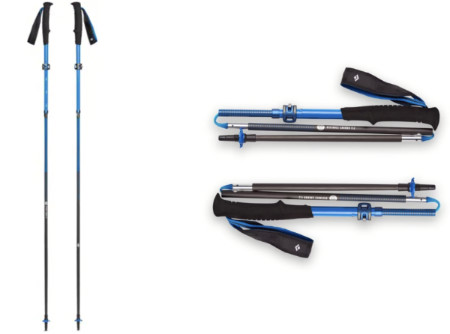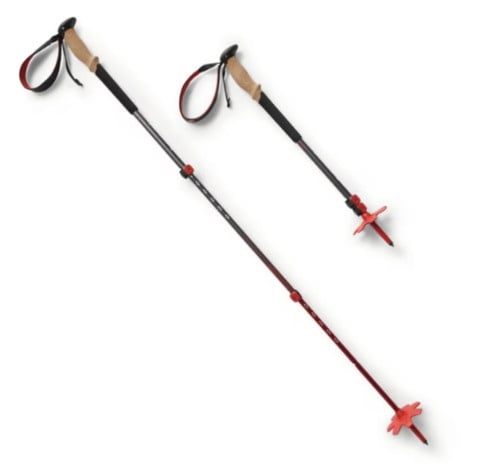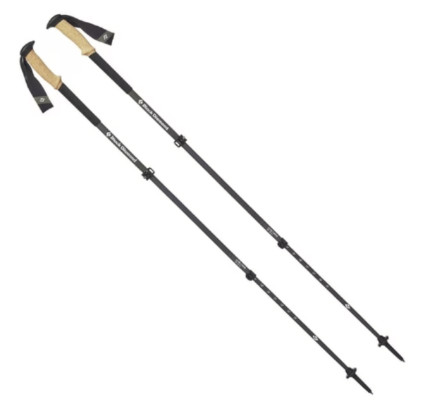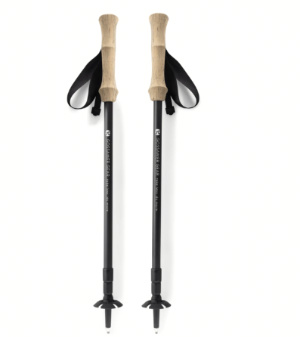Trekking poles provide many benefits to hikers and backpackers, from added stability and balance on rough trails to less wear and tear on knees and hips, especially when hiking downhill. The most popular trekking poles are adjustable in length, with a lever lock adjustment system instead of twist-locks, because they are more reliable to use and easier to fix.
Here are the top 10 trekking poles that we recommend.
Carbon fiber trekking poles have become increasingly popular in recent years and have started to eclipse aluminum poles because of their lighter weight. This trend has been fueled by competition from low-cost manufacturers without huge advertising and marketing budgets, like Cascade Mountain Tech, Trailbuddy, Montem, and others. Some of their products are quite good values, especially for beginner hikers and backpackers, and offer a great way to try trekking poles without breaking the bank.
If you’re still unsure about which poles to purchase, read the explanation of our trekking pole selection criteria and key considerations below. It provides a good introduction to the pros and cons of different trekking pole features and design choices. While brands like Leki and Black Diamond are much more expensive than no-name manufacturers, they are higher quality and have very good warranties that make them worth the price if you’re hard on gear.
1. Black Diamond Distance Carbon FLZ


3. Leki Khumbu Lite Trekking Poles

4. REI Traverse Trekking Poles

5. Leki Black Series FX Carbon Hiking Poles (folding)
6. Black Diamond Alpine Carbon Cork Trekking Poles

7. Gossamer Gear LT5 Carbon Fiber Trekking Poles (ultralight)
8. Black Diamond Trail Trekking Poles

9. Trailbuddy Aluminum Cork Grip Poles (budget)
10. Pacerpole Dual Lock Carbon Fiber Trekking Poles
Key Considerations for Buying Trekking Poles
Here are the important features to consider when choosing which trekking poles to buy, including pros and cons.
Price and Warranties
There is a big price difference between premium poles from Black Diamond and Leki vs less expensive off-brands like Montem, Paria, Cascade Mountain, and the dozens of other trekking pole companies you’ve never heard of on Amazon. When you buy a set of premium poles, they are of better quality, have tighter fitting parts, and have a stiffer feel. Black Diamond and Leki also have much more generous warranty departments and will often replace broken poles or pole segments for free, which can be a big deal if you hike a lot. The off-brands are less expensive but good for people who want to try trekking poles for the first time and don’t want to make a huge investment. Their poles are perfectly usable for hiking, but there is a noticeable difference in durability and longevity over time.
Three-Piece, Two-Piece, Fixed Length, or Folding Poles
Most hikers and backpackers prefer three-piece poles or folding poles over two-piece or fixed-length trekking poles because they’re easier to stow when not used. Folding poles are especially convenient for traveling, although you can also pull apart three-piece poles and reassemble them when you arrive.
Lever Lock or Twist Lock Trekking Pole Adjusters
Multi-piece trekking poles are telescoping, with thinner sections collapsing into thicker ones. When extended there are two main adjustment mechanisms to make them hold their desired length. Lever Locks, called Flick Locks on Black Diamond trekking poles, are external clamps that fold down over the thinner section and prevent them from collapsing further. They are easy to adjust and repair and are very durable. Twist Lock poles rely on a plastic expander inside the poles that expands inside the thicker segment and prevents the thinner tube from moving higher. These expanders tend to wear out over time and stop working, which can be frustrating if you’re in the middle of nowhere. We’ve used both and far prefer lever lock poles because they are so easy to care for and tighten if they loosen up: you tighten an external screw with a penknife or twist it tight with your fingers.
Carbon Fiber or Aluminum Trekking Poles
Many companies claim that carbon fiber poles are lighter weight than aluminum ones, vibrate less, or are more durable. We have not seen any evidence that one material is better than another because poles made with both still break if you trap the tip between rocks or fall on them. The only advantage of aluminum is that you can usually bend it back into shape, whereas carbon fiber shatters. Besides the price (carbon fiber is always more expensive), the most important thing when deciding between the two is whether you can buy replacement sections from the seller when you break a segment or a pole tip.
Cork Handles or EVA Foam Trekking Pole Handles
Most trekking poles come with cork or foam handles. Both repel moisture and provide an excellent grip. In fact, many cork poles have foam extensions under the handle if you need to lower your hands when climbing uphill. Some people will argue that cork is better because it absorbs sweat and molds to your hand over time, although we’re not terribly convinced it does either. Ultimately, it comes down to personal preference and price.
Shock Absorbing Trekking Poles or Regular
Some trekking poles have a shock-absorbing component, usually built into the handle or as a spring between shaft segments, that reduces the shock you’ll feel in your wrists or forearms when hiking over rock trails or asphalt. They can be very helpful in reducing the risk of repetitive stress injuries in your wrists or inflammation if you suffer from carpal tunnel syndrome or arthritis. If you want to try them, we recommend buying them at REI so you can return them if you don’t like the feel of the shock absorption.
Ultralight Carbon Fiber Poles
Some smaller ultralight backpacking companies sell extremely lightweight carbon fiber poles that are considerably lighter than carbon fiber poles from Black Diamond or Leki. These ultralight poles are much less durable and may break frequently depending on your hiking style and terrain. For example, I have a friend who’s used the same pair of Gossamer Gear carbon fiber trekking poles for years, while I consistently broke them within a day. Just be aware that there is usually a durability difference between very thin ultralight carbon fiber poles and thicker and heavier ones.
Trekking Pole Baskets
The trekking pole baskets have several purposes. The small ones called trekking baskets, are designed to prevent your pole tips from getting caught between rocks and broken. The wider ones, called snow baskets, are designed to float on top of the snow so they don’t sink in. Many pole companies don’t include snow baskets in the purchase price of their poles, even though you’d want them for snowshoeing and skiing. It’s something to watch out for if you want poles for four-season use.
Trekking Pole Tips
Most trekking poles come with carbide tips for hiking over bare ground and rock. It’s very difficult to wear these out, and you’re more likely to break them. If either happens, you want to ensure that the poles you buy have replaceable tips and that you can purchase them separately. Many poles also come with rubber tips, which can be used on asphalt. These may be curved on the bottom or just bulbous rubber caps. Either type works well.
Unisex vs Gender-Specific Poles
The main difference between unisex and gender-specific poles is length and grip size. Men’s and unisex poles tend to be an inch longer than women’s poles and have a narrower grip because women tend to have smaller hands. Otherwise, they’re interchangeable.
Trekking Pole Tents
If you plan on using trekking poles to set up a trekking pole tent, make sure you get ones that are long enough and adjustable. Folding poles are often fixed length when expanded and may or may not be adjustable, depending on the make and model.
Check Out All of SectionHiker’s Gear Guides!
SectionHiker is reader-supported. We only make money if you purchase a product through our affiliate links. Help us continue to test and write unsponsored and independent gear reviews, beginner FAQs, and free hiking guides.




